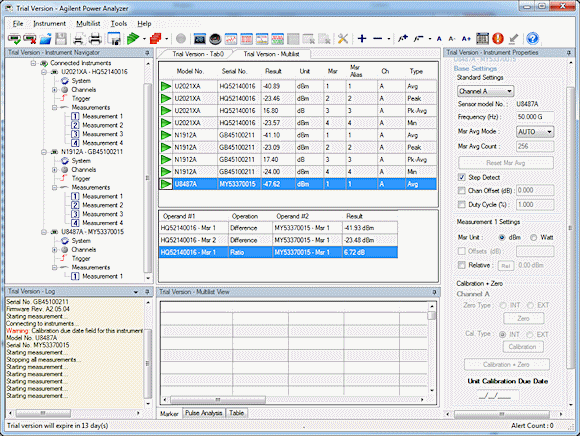
Introduction
Manufacturers and operators of communication satellites face many challenges in making accurate and repeatable power measurements due to the ever increasing complexity in satellite system design and the need to support increased data rates. Modern satellite communication systems operate at microwave frequencies such as X, Ku, and Ka bands, which help support a wider modulation bandwidth, increase capacity, and enable the use of smaller antennas. The increase in bandwidth, coupled with high operating frequencies, creates significant challenges for RF engineers who are testing a satellite system, module or component.
The selection of correct power measurement tools will dictate if users are able to obtain repeatable, accurate and traceable power measurements for installation, maintenance or manufacturing of the satellite system. This article briefly describes the power measurement needs in satellite applications, and important selection criteria for choosing the right equipment. Satellite Applications
Power Measurements
Power measurements are critical, whether they are for field testing or manufacturing applications. For field testing, the signal received at the earth station is usually very weak due to long distances between a satellite and earth station. Continuous monitoring of the received signal is therefore important to ensure that the communication link can operate properly.
In manufacturing, the satellite will have to be tested meticulously over a wide range of environmental conditions in a thermal vacuum chamber to simulate conditions in space. Multi-channel power measurements will be performed to monitor as many as 20 channels of output power from the transmitters to detect any power instability or glitches. Additionally, many components in a satellite system, such as the travelling wave tube amplifier (TWTA) and repeater, will need to be tested to ensure they output the right power and frequency and will not cause interference with the receiver.

Figure 1: Long distance, multi-channel power measurement with USB power sensors
and a network USB hub
Selecting the Right Power Meter and Sensor
The right selection of power measurement tools will simplify the work and ensure accurate, repeatable power measurements. Some key considerations are listed below.
- Frequency range: Many satellite communication systems operate at microwave frequencies identified in bands, such as the X, Ku and Ka bands. It is therefore important to choose a power sensor that can measure up to 40 GHz.
- Type of measurements: Typical satellite performance monitoring requires simple average power measurements. Depending on the modulation bandwidth of the signal, it might be crucial to select a sensor that is capable of making RMS-power measurements of wide bandwidth signals. Using a CW-only sensor will result in measurement inaccuracy, especially in the high power region.
- Zero and calibration: Access to the power sensor is not always possible during remote monitoring of a satellite antenna tower or when testing in a chamber. The sensor must be capable of performing accurate, long-term testing remotely. Features such as internal zero, calibration and excellent long-term drift performance must be considered during the selection of the right power sensor. A sensor with internal zero and calibration allows users to perform zeroing and calibration while the sensor is still connected to a DUT. This enables the sensor to operate independently in the satellite terminals for many months.
- Multi-channel, remote monitoring: Due to the long distance from the control room to the satellite antenna dish, it is important to choose a power sensor with a connection range that can be extended up to several hundred feet. A USB power sensor is an ideal solution as its connection range can be extended up to 90 meters when the sensor is paired with a network USB hub or extender. The companion software that shipped with the sensor can also be used to control and display multiple sensors simultaneously. Some other useful feature includes limit/alert function and long term data logging with time stamp.
- Stability over temperature: During testing in the thermal vacuum chamber, the satellite will be subject to extreme temperatures tests. A power sensor that comes with built-in temperature compensated calibration factors will ensure that measurements are accurate over a wide temperature range.

Fig. 2: Multi-list display format of the Agilent N1918A power analysis manager, which is capable of supporting more than 20 USB power sensors simultaneously.
Conclusion
Accurate and repeatable measurement of a satellite system depends on the selection of the right power measurement tools. Key considerations include frequency coverage, type of power measurements, the ability to automate the measurements and the power sensor's long term and temperature stability. Careful consideration has to be made in order to find the right tool. Agilent offers a wide variety of power measurement equipment that is suitable for accurate and reliable satellite testing. For more details about Agilent recommended power measurement solutions for satellite testing, read the related application note at the Power Measurement Hints and Tips page.
About the Author
Sook Hua is a Product Planner with Agilent Technologies residing in Penang, Malaysia and is responsible for strategic planning and product portfolio development for RF power meters and sensors. She received her Bachelor Degree of Electrical Engineering from University of Technologies Malaysia (1999) and Masters of Science Degree in Electronic System Design Engineering from University of Science Malaysia (2003). She has spent 14 years in Agilent Technologies with the last nine years attached to General Purpose Electronic Measurement Division under various roles.